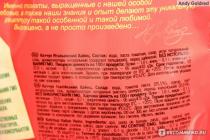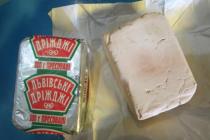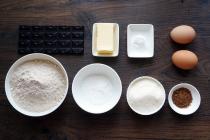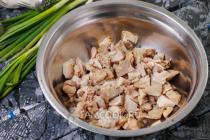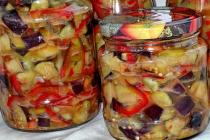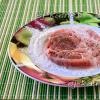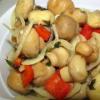§ 4.1. General characteristics of the elements of the subgroup of carbon
The chemical elements of the main subgroup of IV groups include carbon C, silicon Si germanium GE tin SN I. lead PB. In a series of C - Si - GE - SN - PB due to the various chemical nature of the elements, they are broken into two subgroups: carbon and silicon make up contributing carbon, Germany, Tin, Lead - subgroup Germany.
Electronic configurations of an external layer of elements atoms nS. 2 nP. 2, in the compounds, they can exhibit the degree of oxidation from -4 to +4. As in the main subgroup of the V group, there is a change in the chemical properties of the elements: carbon and silicon show the properties of typical non-metals, transitional properties are characterized for Germany, and tin and lead are typical metals. With an increase in the atomic number in a subgroup, the electronegability of the elements is reduced. For carbon and silicon are characterized by covalent compounds, for tin and lead - ionic.
Some properties of the elements of the main subgroup IV group are presented in Table. 4.1.
Table 4.1
Properties of elements
Subgroups of carbon and simple substances
Atomic number | Name, symbol | Radius of atom, nm | Ionization potential | EO | Steppe n. | r, | t.
PL
, | t.
kip
, |
Carbon C. | 0,077 | 11,3 | 2,55 | –4, 0, +2, +4 | 3.52 Almaz 2.27 graphite | 3730 | 4830 |
|
Silicon Si. | 0,117 | 8,2 | 1,90 | –4, 0, +2, +4 | 2,33 | 1410 | 2680 |
|
Germanium GE. | 0,122 | 7,9 | 2,01 | –4, 0, +2, +4 | 5,33 | 937 | 2830 |
|
Tin SN. | 0,142 | 7,3 | 1,96 | –4, 0, +2, +4 | 7,29 | 232 | 2270 |
|
Lead Pb. | 0,154 | 7,4 | 2,33 | 0, +2, +4 | 11,3 | 327 | 1730 |
Data Table. 4.1 confirm that in a series of C - Si - Ge - Sn - Pb there is a monotonous change in properties from non-metallic to metallic. This manifests itself in a decrease in the stability of the compounds of elements in the highest oxidation of +4 and the increase in the stability of the compounds of elements in a low oxidation is +2. For C, Si and GE, the formation of free cations, Sn and Pb is easily formed by the SN 2+ and PB 2+ cations.
The increase in the metal properties is evidenced by the change in the acid-base properties of oxides and hydroxides of elements to the degree of oxidation is +4 when moving from carbon to lead:
CO 2. | SiO 2. | GEO 2. | SNO 2 PBO 2 |
acid Properties | weakly | amphoteric properties | amphoteric properties |
The acid properties of the respective hydroxides are changed similarly.
In a row from carbon to lead, the stability of the oxides of the elements into the degree of oxidation is intensified +2.
Carbon exists in nature in the form of two stable isotopes: 12 C (98.9%) and 13 C (1.1%).
Of great importance is b -radoactive carbon isotope 14 C. At the heart radio carbon The method of determining the age of carbon-containing rocks is the calculation of the relationship of stable and radioactive carbon isotopes.
Carbon is ranked 11th in the prevalence on Earth. It occurs in the atmosphere in the form of CO 2, many minerals and rock formations are formed from it, for example chalk, limestone, marble (the chemical formula of CaCo 3), dolomite (MGCO 3 · Caco 3), Malachite (CUCO 3 · CU (OH) 2). Carbon is part of proteins, nucleic acids, carbohydrates - substances without which life is impossible.
Almost in all compounds (except CO and SiO) carbon and silicon are tetrasal. Carbon atoms in many compounds form chains -c-C-. Polymer structure is also characteristic of silicon compounds, but in contrast to carbon atoms, silicon atoms form branched chains, connecting not with each other, but through oxygen -Si-O-Si-.
Carbon forms several simple substances: diamond, graphite, carbines, fullerene and amorphous carbon.
DIAMONDit is a colorless transparent, strongly refractive light crystals with a density of 3.52 g / cm 3. The structure of the external energy level of the carbon atom in an unexcited state describes the electronic configuration 2 s. 2 2p. 2. In the formation of chemical bonds in the carbon atom, electrons are sprinkled on s.-Provers, and it acquires a configuration 2 s. 1 2p. 3. Orbitals of four unpaired electrons are exposed sP 3.-Hypebridization leading to the formation of four equivalent hybrid orbitals, the angle between which is equal to tetrahedral. Atoms in sP 3.-Hybrid state, and form the structure of the diamond. Diamond is a high-strength substance having a unique hardness and an excellent refractive ability, which is important for creating abrasive materials, cutting tools and jewelry.
GRAPHITE- This is a gray opaque fat to the touch mass of a density of 2.27 g / cm 3. In graphite, carbon atoms are in sp. 2-hybrid state, which causes a layered structure of graphite consisting of flat hexagons. The distances between carbon atoms located in different layers exceed the distances between atoms inside the layer. The layered structure of graphite explains its electro- and thermal conductivity, as well as the ability to leave a trace on the solid surface. To convert diamond to graphite, heating up to 1800-1850 ° C without air access. The reverse process goes at a temperature of 3000 ° C and a pressure of 10 6 -10 7 kPa.
Graphite is widely used as electrode material in electrochemistry; It is included in lubricants, is used as a neutron retarder in nuclear reactors.
Karbinit is a crystalline black powder with a density of 1.9 g / cm 3. To obtain it, a acetylene dehydrogenation reaction is used at 1000 ° C, as a result of which from n. C 2 H 2 molecules is obtained by a polymer with a linear structure -C º C - C º C-C º C-. In this modification, carbon atoms are in sp.-Hybrid state.
Fullerenecondensation of graphite steam condensation products were found. Fullerene C 60 molecule is interconnected by five and six-membered cycles containing carbon in SP 2 and SP 3 - hybrid state. In addition to C 60, the fullerenes of the composition C 70 and C 76 are divided.
Amorphous carbon - the most common altropic modification of carbon . It is most often obtained by decomposition of various organic substances. Sometimes this form is called wood or activated carbon.
SILICON- the most common element in the earth's crust (27.6% by weight). It has three stable isotopes: 28 Si (92.27%), 29 Si (4.68%) and 30 Si (3.05%). In nature, silicon is in the form of silica - SiO 2 silica (IV) oxide (sometimes called it quartz or sand), silicatov and aluminosilicatov, for example, Kal 3 mica (OH, F) 2, asbestos (Mg, Fe) 6 (OH) 6, Talc Mg 3 (OH) 2. Depending on the size of the particles and the content of impurities in SiO 2, during its restoration, various modifications of silicon can be obtained.
Amorphous silicon is a brown powder, crystal - light gray solid fragile crystals of metallic species. In the crystal lattice, every silicon atom is in a state sp. 3-hybridization and is surrounded by four other atoms with which it is associated with a covalent bond - crystalline silicon is similar to diamond.
Silicon is widely used in microelectronics as a semiconductor material for microcircuits and in metallurgy to obtain pure metals.
§ 4.2. Chemical properties of carbon and silicon
1. In reactions with simple substances, formed by more electronegative elements (oxygen, halogen, nitrogen, sulfur), carbon and silicon show properties restores. When heating graphite and silicon with an excess of oxygen, higher oxides are formed, and with a lack of oxygen - monoxides CO and SiO:
E + o 2 \u003d EO 2 (excess oxygen);
2E + O 2 \u003d 2EO (lack of oxygen).
With fluorine, carbon and silicon react under normal conditions with the formation of CF 4 and SiF 4 tetrafluorides, for obtaining CCl 4 and SiCl 4 tetrachlorides, it is necessary to heat the reacting substances. Sulfur and nitrogen reactions with carbon and silicon only with strong heating:
C + 2S CS 2;
2C + N 2 C 2 N 2;
Si + 2S SIS 2.
When the mixture of quartz sand and coke is heated at a temperature of about 2000 ° C, silicon carbide is formed, or carborundum - refractory substance, hardness close to diamond:
SiO 2 + 3C \u003d SIC + 2CO.
Carbon is often used to restore low-effective metals from their oxides and to transfer metal sulfates to sulphides:
Cuo + C CU + CO,
Baso 4 + 4c BAS + 4CO.
2. Acid reactions. To the action of conventional acids carbon and silicon is stable. Carbon is oxidized by concentrated sulfuric and nitric acids:
C + 2H 2 SO 4 \u003d CO 2 + 2SO 2 + 2H 2 O;
3C + 4HNO 3 \u003d 3CO 2 + 4NO + 2H 2 O.
Silicon in concentrated sulfuric and nitric acids is passivated and dissolved in mixtures of concentrated nitric and platform acids and: concentrated nitrogen and hydrochloric acids
3SI + 4HNO 3 + 18HF \u003d 3H 2 SIF 6 + 4NO + 8H 2 O.
In this reaction, nitric acid plays the role of an oxidizing agent, and a plug-in or salt-complexing agent.
3. Alkalicham reactions. Silicon dissolves in aqueous solutions by alkali with hydrogen release:
SI + 2NAOH + H 2 O \u003d Na 2 SiO 3 + 2 H 2.
4. Interaction with water. Under normal conditions, silicon with water does not interact, but at high temperatures it reacts with water vapor:
Si + \u003d H 2 SiO 3 + 2H 2.
5. Oxidative properties Carbon and silicon are manifested in reactions with active metals, while they are formed carbide and silicides.:
CA + 2C \u003d CAC 2;
2mg + Si \u003d Mg 2 Si.
6. Carbon and silicon are capable disproportionate When heated with oxides of active metals, forming oxides, carbides and silicides:
Cao + 3C \u003d CAC 2 + CO;
2AL 2 O 3 + 9C \u003d Al 4 C 3 + 6Co;
2MGO + 3SI \u003d MG 2 Si + 2SIO.
§ 4.3. Oxygen compounds of carbon and silicon
Carbon oxide (II) CO, or ditch gas, under normal conditions - gas without color and smell, t. pl \u003d -205 ° C, t. Kip \u003d -191,5 ° C. It is very poisonous, burns with a bluish flame, lighter than air, poorly soluble in water (2.3 volume CO per 100 volumes H 2 O at 293 K).
Curmarket gas is formed when carbon burning in a disadvantage of oxygen, in addition, CO can be obtained by reacting hot coal with water vapor or carbon dioxide:
C + H 2 O CO + H 2;
CO 2 + C 2CO.
Getting.In the laboratory CO is obtained by dehydrating ant or oxalic acids in the presence of sulfuric acid as a watering agent:
HCOOH CO + H 2 O;
H 2 C 2 O 4 CO + CO 2 + H 2 O.
Chemical properties. 1. When carbon oxide passes (II) in the melt of alkali at high pressure, formic acid salt is formed:
CO + KOH \u003d HCOOK.
This reaction, as well as the laboratory method for producing CO dehydration of formic acid, make it formally believed that CO - anhydride of formic acid.However, this statement is exactly formally, since the inverse process of obtaining formic acid during hydration of carbon monoxide is impossible.
The degree of carbon monoxide degree in carbon monoxide - +2 - does not correspond to the structure of the CO molecule, in which in addition to the two bonds formed during the pairing of carbon electrons and oxygen, there is another, formed by a donor-acceptor mechanism due to a vapor pair of electron oxygen (depicted by an arrow) :
The presence of triple communication explains the strength of the CO molecule and its low reaction capacity at normal temperature. Under normal conditions, carbon monoxide do not interact With water, alkalis and acids.
2. At elevated CO temperature, interacts with oxygen and metal oxides:
2Co + O 2 \u003d 2CO 2;
Feo + CO \u003d Fe + CO 2.
3. When a mixture of carbon monoxide with chlorine through a layer of activated carbon can be obtained by a poisoning substance - poisonous gas phosgenecausing airway paralysis:
CO + CL 2 \u003d COCL 2.
4. When heated carbon monoxide with hydrogen, methyl alcohol is formed at elevated pressure:
CO + 2H 2 → with H 3 OH.
Carbonyls.Carbon (II) oxide interacts with many transition metals to form volatile compounds - carbonyl:
Ni + 4Co \u003d Ni (CO) 4.
In the CO molecule, the carbon atom has a lotwise electron steam, which causes the donor properties of this molecule. The covalent bond Ni - C in the nickel carbonyl molecule is formed according to the donor-acceptor mechanism, and the electron density is shifted from the carbon atom to the nickel atom. An increase in the negative charge on the metal atom is compensated by the participation of it d.-Electrons in the formation of communication, therefore the degree of metal oxidation in carbonyl is zero.
Metal carbonyls are soluble in non-polar solvents, bats. They are used to obtain pure metals, because when heated, they decompose on metal and carbon monoxide (II). To determine the composition of carbonyls use the so-called rule 18 electrons:the total number of valence electrons of the metal and electrons provided by CO molecules (2 from each) should be equal to 18. Metals with an odd atomic number cannot form in such a 18-electron shell, so they are characterized by polymer (mostly dimeric) carbonyls, For example 2. In dimeric carbonyls, the metal - metal - metal, and CO molecules carry out a bridal connection.
CO carbon oxide is a good reducing agent of silver salts from ammonia solutions of its salts:
2OH + CO \u003d 2AG ↓ + (NH 4) 2 CO 3 + 2 NH 3
Silicon oxide (II)SiO is obtained by joint evaporation in a vacuum of a mixture of SiO 2 and Si at a temperature of 1100-1300 ° C. To restore SiO 2 oxide into SiO monoxide, hydrogen or carbon can also be used, the processes should be carried out at a temperature of 1000 ° C.
SiO 2 + H 2 \u003d SiO + H 2 O;
SiO 2 + C \u003d SiO + CO.
Silicon (II) oxide is a brown powder that is quickly oxidized into dioxide in air. In alkalis and plastic acid, SiO is easily dissolved.
This compound is used mainly as pigment for oil paints and polishing agent.
Carbon Oxide (IV) (carbon dioxide, carbon dioxide, coal anhydride) CO 2 - gas without color and smell, not supporting breathing and burning, heavier air, t. PL \u003d -57 ° C at a pressure of 5 atm, soluble in water (88 volumes of CO 2 in 100 volumes H 2 O at 20 ° C). Under normal pressure, the carbon dioxide is moving into a gaseous state, bypassing the liquid ( sublimated). At normal temperature under pressure of 60 atm, the gas turns into a liquid. CO 2 Linear Molecule, with two double connections:
O \u003d C \u003d O
In industry To obtain carbon oxide (IV), high-temperature marble decomposition is used:
Caco 3 Cao + CO 2.
In the laboratory To obtain large quantities of carbon dioxide on marble, hydrochloric acid operate:
Caco 3 + 2HCl \u003d CaCl 2 + H 2 O + CO 2.
To detect the released CO 2, it is passed through lime water, while the white precipitate of calcium carbonate falls:
Ca (OH) 2 + CO 2 \u003d Caco 3 ¯ + H 2 O.
It must be remembered that in the atmosphere of CO 2 burning magnesium does not go out, but continues to burn:
2mg + CO 2 \u003d 2MGO + C
CARBONIC ACID H 2 CO 3 in minor quantities is formed when the carbon dioxide is dissolved in water, while the following equilibrium exists in the solution:
H 2 O + CO 2 ↔ H 2 CO 3 ↔ H + + ↔ 2H + +.
At 25 ° C K. 1 \u003d 4 × 10 -7, K. 2 \u003d 5 × 10 -11.Coalic acid is very weak and unstable in free form. It has the following structure:
As a two-axis acid, it forms medium salts ¾ carbonates and sour ¾ hydrocarbonates. Under action on salt of carbonic acid of strong acids, carbon dioxide is distinguished, which is used as qualitative reactionon these salts:
NaHCO 3 + HCl \u003d NaCl + CO 2 + H 2 O;
Baco 3 + 2HCl \u003d BaCl 2 + CO 2 + H 2 O.
Of all carbonates in water are soluble only alkali metal carbonates (Li 2 CO 3 soluble worse) and ammonium. Hydrokarbonates of most metals are well soluble in water.
Under the action of excess carbon oxide (IV), the carbonates are insoluble in water turn into soluble hydrocarbonates:
Caco 3 + H 2 O + CO 2 \u003d Ca (HCO 3) 2.
When heated, the bicarbonates are disintegrated into carbonates, carbon dioxide and water:
2NAHCO 3 Na 2 CO 3 + H 2 O + CO 2.
All carbonates, in addition to thermally stable alkali metal carbonates, are decomposed on metal oxide and carbon dioxide:
Caco 3 Cao + CO 2.
In addition to medium and sour carbonates, known maintenance Carbonates. They are formed under action on salts of low-effective metals by medium carbonates:
2Cuso 4 + 3NA 2 CO 3 + 2H 2 O \u003d
\u003d Cu (OH) 2 · CUCO 3 + 2NAHCO 3 + 2NA 2 SO 4.
The main carbonate CU (OH) 2 · CUCO 3 is known in nature called "Malachite".
Soda Na 2 CO 3 and its various crystallohydrates are most of the most practical significance of the coalic acid: Na 2 CO 3 × 10H 2 O (crystalline soda), Na 2 CO 3 × 7H 2 O and Na 2 CO 3 × H 2 O, and Also Potash K 2 CO 3, chalk, limestone and marble having the composition of CACO 3.
Silicon Oxide (IV), or silica, SiO 2 ¾ solid, very refractory substance (melting point of more than 1700 ° C), occurs in nature in the form of minerals quartz, cristobalitis and tridimitis.
At normal temperature, a stable modification is quartz, with increasing temperature, polymorphic transformations are observed:
quartz Tridimitis Cristobalite melt.
Structure.In all its modifications, silicon dioxide is always polymer (SiO 2) N. and built of tetrahedra forming a very solid atomic grille. Each silicon atom in crystals (SiO 2) N. Surrounded by four oxygen atoms, which are bridged and bind at different angles of tetrahedra. As a result, a three-dimensional crystal lattice is formed, in which the mutual arrangement of tetrahedra in space defines one or another modification of silica.
Quartzit is found in nature in the form of well-formed colorless crystals, called mountain crystal. There are also painted quartz varieties: pink quartz, purple ( amethyst), dark brown (smoky topaz), green ( chrysoprase). Small-crystalline modification of quartz with impurities of other substances is called chalcedony. The varieties of chalcedone are agat, Yashma And others. Rhinestone and painted quartz varieties are used as precious and semi-precious stones.
Quartz is widely used in various fields of science, technology and microelectronics, and often for the needs of the latter, artificial crystals with certain parameters of the crystal lattice are grown.
Some quartz crystals are able to rotate the plane of the polarization of light, and there may be both right- and left-handers. Those and other crystals differ from each other as a subject from their mirror image. Such crystals are optical isomers.
Tridimitisin small quantities it is found in volcanic rocks. Known tridimitis and meteoric origin. Cristobalite., like tridimitis, sometimes occurs in the form of small crystals included in Lava. Tridimitis and crystobalite have a more loose structure than quartz. Thus, the density of the crystobalitis, the tridimitis and quartz is equal to 2.32; 2.26 and 2.65 g / cm 3.
With slow cooling of the melt, silica is formed amorphous Quartz glass. Silica in the form of glass is found in nature. The density of amorphous glass is 2.20 g / cm 3 - lower than in all crystalline modifications. At temperatures above 1000 ° C, the quartz glass is "discharged" and goes into crystobalitis, therefore, in quartz laboratory dishes, experiments can be carried out only at temperatures below 1000 ° C.
Chemical properties. 1. All forms of SiO 2 in water are practically insoluble, under normal conditions there are only alkali solutions, fluorine, fluorine gaseousand hydrofluoric acid:
SiO 2 + 2KOH \u003d K 2 SiO 3 + H 2 O;
SiO 2 + 4HF \u003d SIF 4 + 2H 2 O;
SiO 2 + 6HF \u003d H 2 + 2H 2 O.
The last reaction is used when the glass is etched.
2. Silicon dioxide - typical acid oxideTherefore, when weaving, it reacts with the main oxides, alkalis and carbonates with the formation of silicates:
SiO 2 + CaO \u003d Casio 3;
SiO 2 + 2NAOH \u003d Na 2 SiO 3 + H 2 O;
SiO 2 + Na 2 CO 3 \u003d Na 2 SiO 3 + CO 2.
The above reactions of silicon dioxide with oxides and salts underlie the industrial production of various glass, as well as cement.
Glass.The usual glass having the composition of Na 2 O × Cao × 6SiO 2 is obtained by fusion of the soda, sand and limestone mixture at a temperature of about 1400 ° C until completely removal of gases:
Na 2 CO 3 + CACO 3 + 6SIO 2 \u003d Na 2 O × Cao × 6Sio 2 + 2CO 2.
With the addition of barium oxides, lead and boron, special varieties of glasses are obtained, for example refractory, unbreakable. To obtain colored glasses, various oxides of transition metals are used, for example, the addition of cobalt oxide (III) CO 2 O 3 gives blue, chromium oxide (III) CR 2 O 3 ¾ Green, manganese dioxide MNO 2 ¾ pink.
Cements.Silicates are widely used for production cement - binder, which, when mixing with water, hardens. You can select two types of cements on the principle of their grasp ¾ normal Cement I. portland cement. The process of setting the conventional cement due to the formation of calcium carbonate in the interaction of carbon dioxide air and calcium silicate:
Casio 3 + CO 2 + H 2 O \u003d Caco 3 ¯ + H 2 SiO 3 ¯.
Calculation Portland cement occurs as a result of silicate hydrolysis, followed by the formation of insoluble crystalline hydrogen:
Ca 3 SiO 5 + H 2 O \u003d Ca 2 SiO 4 + Ca (OH) 2;
Ca 2 SiO 4 + 4H 2 O \u003d Ca 2 SiO 4 × 4H 2 O ¯.
Silicon acids action is obtained by the action of mineral acids on silicate solutions or hydrolysis of halides and silicon sulfides, since the direct interaction of silica with water is impossible.
The composition of silicon acids can be expressed by the general formula x.SiO 2 × y.H 2 O, where x. and y. ¾ whole numbers. For x. = 1, y. \u003d 1: We obtain SiO 2 × H 2 O. Е. H 2 SiO 3 ¾ methacremium acid; for x. = 1, y. \u003d 2 - SiO 2 × 2H 2 O, i.e. H 4 SiO 4 ¾ orthosilicic acid; for x. = 2, y. \u003d 1 - 2Sio 2 × H 2 O, i.e. H 2 Si 2 O 5 ¾ two-poremneyevoya acid.
If a y.\u003e 2, then acids belong to polycremnyyev.
Silicates -salts methacremium, or just silicic acid H 2 SiO 3. Of these, only sodium and potassium silicates and potassium called liquid glass are soluble in water. Liquid glass is used to strengthen the soils for the manufacture of silicate glue and refractory fabrics. The remaining silicates ¾ refractory, insoluble in water substances. When heating silicic acid decomposes:
H 2 SiO 3 SiO 2 + H 2 O.
When storing in air, silicate solutions are purified due to a silicic acid displacement with carbon dioxide gas contained in the air: silicic acid is weaker than coal; The dissociation constant H 2 SiO 3 to the first stage is 2.2 × 10 -10.
The reaction of silicate with carbon dioxide is qualityto detect silicate ions:
Na 2 SiO 3 + CO 2 + H 2 O \u003d Na 2 CO 3 + H 2 SiO 3 ¯.
The aqueous solutions of soluble silicates have a strong medium reaction due to hydrolysis:
K 2 SiO 3 + H 2 O 2KOH + H 2 SiO 3 ¯.
§ 4 .4. Carbides and silicides
Carbon and silicon compounds with less electronegative elements (most often with metals) are called carbide and silicides. In addition to the reactions, the equations of which are given above (see § 13.2), to obtain silicides, use the rings of hydrides of metals with silicon:
2CAH 2 + Si \u003d Ca 2 Si + 2H 2;
restoration of metals from their silicon oxides or carbon in the presence of silicon oxide:
2Cao + 3Si \u003d 2Casi + SiO 2;
Cao + SiO 2 + 3C \u003d Casi + 3Co;
the interaction of metals with SiCl 4 in hydrogen atmosphere:
BA + SICL 4 + 2H 2 \u003d BASI + 4HCl.
All these reactions occur at high temperature and sometimes at elevated pressure.
Among the ion carbides are distinguished by the so-called methanes and acetylinides. Methanids It can be considered as methane derivatives containing carbon to oxidation -4: BE 2 C, Al 4 C 3. They are intensively decomposed with water with methane release:
AL 4 C 3 + 12H 2 O \u003d 4AL (OH) 3 ¯ + 3CH 4.
Acetylens- Acetylene derivatives, in them the degree of carbon oxidation is -1: Li 2 C 2, Ag 2 C 2, Cu 2 C 2, Cac 2, Al 2 (C 2) 3, Fe 2 (C 2) 3. The silver and copper (I) acetylenes are obtained by passing acetylene through an ammonia solution of silver oxide or copper chloride (I). Acetylenyides - strongly explosives and are intensively decomposed with water and acids with acetylene selection:
CAC 2 + 2H 2 O \u003d Ca (OH) 2 + C 2 H 2;
CUC 2 + 2HCl \u003d CUCl 2 + C 2 H 2.
§ 4.5. Hydrogen compounds of elements of the fourth group
Consider only hydrogen compounds of silicon (silane), Germany (German), tin (stananans) and lead (plumes), since the chemistry of hydrogen compounds of carbon will be set forth and organic chemistry.
Getting.In the interaction of active metals (MG, Ca, Li) with water and acids, the simplest hydrogen compound of silicon is distinguished with water and acids - monosilantSih 4, which is most often called simply sylan:
Ca 2 Si + 4HCl \u003d 2cacl 2 + Sih 4.
The most common method of producing hydrogen-containing compounds of elements of the fourth group is the interaction of tetrachloride elements with lithium tetrahydroalumum:
GECL 4 + LI [ALH 4] \u003d GEH 4 + LICL + ALCL 3
Building and properties. Milnis produced in its structure are similar to hydrocarbons. The silane molecule has the form of the correct tetrahedron with a silicon atom in the center. Sylan is a colorless gas having a smell of mold, spontaneously flammable in air, t. pl \u003d -185 ° C, t. Kip \u003d -112 ° C. Sylan is strongly poisonous.
Unlike methane, Silan interacts with alkalis solutions:
SIH 4 + 2KOH + H 2 O \u003d K 2 SiO 3 + 4H 2.
Water also hydrolyzys sililate, but much slower:
SIH 4 + 2H 2 O \u003d SiO 2 + 4H 2.
When heated above 400 ° C, silicon decays on silicon and hydrogen, this property is used to obtain pure silicon:
Sih 4 \u003d Si + 2h 2.
Like hydrocarbons, silanes form the homologous series Si N.H 2. n.+2. It is individually highlighted silane to n \u003d 14 inclusive. Like alkanam, silanes are colorless, the first members of the homologous series under normal conditions of gaseous, the following fluids. The chemical activity of silanes is much higher than hydrocarbons. This is due to the smaller compared to the carbonaceous affinity of silicon to hydrogen and the very large affinity of silicon to oxygen, as well as with lower strength of Si - Si communication compared with the connection of C - S. low strength of the Si - Si connection due to the limitations of the homologous series of silanes.
Sylan, Herman and Stannan, are strong reducing agents:
SIH 4 + 2AGCL \u003d SIH 3 CL + HCl + 2AG
§ 4 .6. Silicon compounds with halogens
Silicon compounds with halogens can be considered as derivatives of silanes in which hydrogen atoms are fully or partially substituted on halogen. Silicon tetragalends are obtained directly from simple substances. The silicon reaction with fluorine occurs already at normal temperature, with chlorine, bromine and iodine - when heated. When skipping the current SIF 4 through water is formed silmeftorioptoric Acid H 2 SIF 6:
3SIF 4 + 2H 2 O \u003d SiO 2 + 2H 2 SIF 6.
Anhydrous silicon-powered hydrochloric acid is not highlighted. An aqueous solution is one of the strongest inorganic acids. Diluted solutions are used as a disinfectant in the food industry. The soluble salts of siliconoftoric acid are used for the impregnation of walls of buildings constructed from calcium-containing building materials:
2Caco 3 + MgSIF 6 \u003d SiO 2 + 2CAF 2 + MGF 2 + 2CO 2.
As a result of the reaction, fine powder SiO 2 is formed, which closes all the pores, gives the walls water resistance and durability.
§ 4.7. Some features of the elements of the subgroup of Germany
Germaniumcontained in many minerals, but in very small quantities, so it is called scattered element. The most important minerals Germany: germanite Cu 2 S × Cus × Ges 2, arginian AG 8 GES 6, renerit Cu 3 (Fe, GE) S 4.
Main minerals tin - cassiterit SNO 2 ( tod stone), lead - galena PBS ( galena). Lead as a finite product of the radioactive decay of uranium is contained in uranium minerals.
In a series of GE - Sn - Pb, the activity of substances in relation to oxygen increases. Under normal conditions, GE and SN are resistant to air, while lead is oxidized to PBO oxide.
Tin and lead react with dilute hydrogen and sulfuric acids with hydrogen release, and Germany does not react with non-oxidant acids.
Germanium is oxidized by concentrated nitric, sulfuric and plating acids:
GE + 4H 2 SO 4 GE (SO 4) 2 + 2SO 2 + 4H 2 O;
GE + 6HF \u003d H 2 GEF 6 + 2H 2;
GE + 4HNO 3 \u003d Geo 2 + 4NO 2 + 2H 2 O.
Germany dissolves in "royal vodka":
3GE + 4HNO 3 + 12HCl \u003d 3GeCl 4 + 4NO + 8H 2 O
and in alkalis solutions in the presence of oxidizing agents:
GE + 2NAOH + 2H 2 O 2 \u003d Na 2.
In the interaction of tin with concentrated nitric acid, tin acid H 2 SNO 3 is formed:
SN + 4HNO 3 \u003d H 2 SNO 3 + 4NO 2 + H 2 O.
In the diluted HNO 3 tin behaves like metal, forming tin nitrate (II):
3SN + 8HNO 3 \u003d 3SN (NO 3) 2 + 2NO + 4H 2 O.
Lead in reactions with nitric acid of any concentration acts as a metal and forms lead nitrate (II) PB (NO 3) 2.
Among the compounds of the German subgroup in the degree of oxidation (IV) for lead oxide are characterized by oxidative properties, it is capable of oxidizing water to oxygen, Mn +2 ion to MNO 4 -:
2MNSO 4 + 5PBO 2 + H 2 SO 4 \u003d 5PBSO 4 ↓ + 2HMNO 4 + 2H 2 O.
In a number of compounds GE (II) - Sn (II) - PB (II), rehabilitation properties are weakened, the most strong reducing agents are transparent Germany and tin:
Na + 2Bi (NO 3) 3 9NAOH \u003d 2BI ↓ + 3 Na 2] SN (OH) 6] + 6Nano 3
IV Group Home Subgroup
Application
Germany is widely used as a semiconductor. Almost half of the tin produced goes to the manufacture of tin, the main consumer of which is the production of canned food. A significant amount of tin is spent on obtaining alloys - bronze (copper + 10 - 20% SN). Oxide tin (IV) is used for the manufacture of semiconductor sensors. Chemical semiconductor sensors are sensitive elements based on SNO 2, in 2 O 3, ZnO, TiO, transforming the energy of the chemical process into electrical. The interaction of the determined gas (O 2, CO, NO 2) with sensitive sensor material causes a reversible change in its electrical conductivity, which is registered by the electronic device.
Elements IV (14 for the new yupak nomenclature) of the main subgroup group include: carbon with, silicon Si, Germany GE, Tin SN, lead PB.
In the basic state, the atoms of the pnikogen have an electronic configuration of the external energy level - ... NS 2 NP 2, where N is the main quantum number (period number). For atoms of elements IV of the group of the main subgroup, the following oxidation degrees are characterized: for carbon - (-4, 0, +2, +4); for silicon - (-4, 0, (+2), +4); For Germany - ((-4), 0, +2, +4); For tin - (0, +2, +4), for lead - (0, +2, +4).
The stability of compounds with the highest oxidation of +4 is maximal for silicon and decreases in the GE - SN - PB. This is explained by the fact that the cost of energy for the transfer of an electron with S per p sucks are not compensated by the energy of the resulting chemical bonds. The stability of compounds with the degree of oxidation is +2 increases.
In tab. 1 presents the main properties of IV (14) of the group of the main subgroup.
| Property | WITH | SI | GE. | SN. | PB. |
| Shage nucleus | |||||
| Electronic configuration of the external energy level in the main state | ... 2s 2 2p 2 | ... 3S 2 3P 2 | ... 4s 2 4p 2 | ... 5s 2 5p 2 | ... 6s 2 6p 2 |
| Orbital radius, PM | |||||
| Ionization energy, eV | 11,26 | 8,15 | 7,90 | 7,34 | 7,42 |
| Electron Energy Energy, EV | 1,26 | 1,38 | 1,2 | 1,2 | – |
| Melting point, ºС | 3300 (subl.) | ||||
| Boiling temperature, ºС | – | ||||
| Electricity: halfning over Ollred-Rokhov | 2,55 2,50 | 1,90 1,74 | 2,01 2,02 | 1,96 1,72 | 2,33 1,55 |
In the IV group, the main subgroup is on top of the down orbital radius increases. Uneven change of radius during the transition from Si to GE and from Sn to PB is due to the effects D and F compression. 3D electrons and 4f-sublevels weakly shielded atom nuclei charge. This leads to the compression of electronic shells of Germany and lead due to an increase in the effective charge of the kernel.
In the IV group, the main subgroup from top to bottom is the effective charge of the nucleus increases, the orbital radius also increases, the ionization energy decreases, the reducing properties of atoms increase.
Carbon differs from other atoms of elements IV group of the main subgroup of the high value of the ionization energy.
The carbon atom does not have free D-orbitals, the valence electrons of the carbon atom (... 2S 2 2p 2) are weakly shielded from the action of the nucleus, which explains the small radius of the carbon atom and the high values \u200b\u200bof the ionization and electronegativity energy.
In the IV group, the main subgroup from top to bottom is the effective charge of the nucleus increases, the orbital radius increases, the energy of the electron affinity decreases, the oxidative properties of atoms are reduced.
The energy of the electron affinity at the carbon atom is less than that of a silicon atom, which is associated with a small radius of carbon atom and a strong interelectronic repulsion when the electron is connected to the atom.
In the IV group, the main subgroup on top down the ionization energy decreases, the energy of the electron affinity decreases, electronegability decreases.
With a change in the energy of ionization of the property of elements IV, the main subgroup group varies from typical non-metals to metals. Carbon and silicon - typical non-metals, Germany - Metalloid with characteristic metal properties, tin, lead - metal.
In the IV group, the main subgroup from top to bottom of the melting and boiling point is reduced.
The decrease in the melting point is due to an increase in the share of metallic communication.
Lesson plan
The overall characteristics of the elements of the IV A group.
Carbon and silicon
Goal:
Educational: To form students with the general idea of \u200b\u200bthe elements of the elements of the 4th group, study their basic properties, consider their biochemical role and the use of basic elements compounds.
Developing:develop the skills of writing and oral speech, thinking, the ability to use the knowledge gained to solve various tasks.
Raising:rail a feeling of the need to know new.
During the classes
Repetition of the topic passed:
How many elements refers to nonmetallam? Indicate their place in PSHE?
What elements are organogenic?
Specify the aggregate state of all non-metals.
From how many atoms consist of non-metallic molecules?
What oxides are called non-forming? Write formulas from non-forming non-metal oxides.
Cl 2 → HCL → CUCL 2 → ZNCL 2 → AGCL
The last response equation is recorded in ion form.
Provide possible reaction equations:
1) H 2 + Cl 2 \u003d 6) Cuo + H 2 \u003d
2) Fe + Cl 2 \u003d 7) KBR + I 2 \u003d
3) NaCl + Br 2 \u003d 8) Al + i 2 \u003d
4) br 2 + ki \u003d 9) f 2 + H 2 O \u003d
5) Ca + H 2 \u003d 10) SiO 2 + HF \u003d
Write equations of nitrogen reaction reactions with a) calcium; b) with hydrogen; c) with oxygen.
Implement the chain of transformations:
N 2 → Li 3 N → NH 3 → NO → NO 2 → HNO 3
With the decomposition of 192 g of ammonium nitrite on the NH 4 NO 2 \u003d N 2 + 2H 2 o reaction, 60 liters of nitrogen were obtained. Find the product output from theoretically possible.
Studying a new material.
To 4 and the group includes P-elements: carbon, silicon, germanium, tin and lead. The difference in the number of energy levels, the unexcited atoms have at the external level of 4 electrons. Due to the increase in the group from top to bottom of the number of filled electronic layers and the size of the atom weakened the attraction of external valence electrons to the kernel, so the non-metallic properties of the elements in the subgroup on top are weakened and metallic properties are reinforced. Nevertheless, carbon and silicon differ significantly by properties from other elements. These are typical non-metals. Germany has metal signs, and tin and lead they prevail over non-metallic.
In nature carbon It occurs in a free state in the form of diamond and graphite. Carbon content in the earth's crust is about 0.1%. It is part of natural carbonates: limestone, marble, chalk, magnesite, dolomite. Carbon is the main component of organic substances. Coal, peat, oil, wood and natural gas are usually considered as combustible materials used as fuel.
Physical properties. Carbon as a simple substance exists in several allotropic forms: diamond, graphite, carbines and fullerene, which have sharp different physical properties, which is explained by the structure of their crystalline lattices. Carbins -small-crystalline powder of black color, for the first time synthesized in the 60s by Soviet chemists, was later found in nature. When heated to 2800º, without air access, it turns into graphite. Fullerene - In the 80s, spherical structures formed by carbon atoms were synthesized, called fullerenes.They are closed structures consisting of a certain number of carbon atoms - from 60, from 70.
Chemical properties.In chemical terms carbon under normal conditions inert. Reactivity is enhanced by increasing the temperature. At high temperatures, carbon interacts with hydrogen, oxygen, nitrogen, halogens, water and some metals and acids.
When water vapor passing through hot coal or coke, a mixture of carbon monoxide (II) and hydrogen is obtained:
C. + H. 2 O. = Co. + H. 2 (water par ),
This reaction is held at 1200º, at temperatures below 1000º oxidation occurs SO 2 :
C + 2.H. 2 O. \u003d S 2 + 2 H. 2 .
An industrial process is the conversion of water gas into methanol (methyl alcohol):
CO + 2.H. 2 \u003d SN 3 IS HE
Under the influence of high temperatures, carbon is able to interact with metals, forming carbide,among them, "methanes" and "acetylens" are isolated, depending on which gas is allocated when they interact with water or acid:
Sas 2 + HCL = CACL 2 + C. 2 H. 2
Al 4 C. 3 + 12 H. 2 O. = 2 Al(Oh.) 3 ↓ + 3 Ch 4
Calcium carbide, which is obtained by heating the lime of SAO and coke in electric hollows without aircraft access:
SAO + 3C \u003d CAC 2 + S
Calcium carbide is used to obtain acetylene:
Sas 2 + 2 H. 2 O. \u003d Sa (he) 2 + C. 2 H. 2
However, the carbon is characterized by reactions in which it exhibits reducing properties:
2 Zno. + C. = Zn. + S 2
C.carbon monitoring.
Carbon oxide (CO) - damp gas. In industry, it is obtained by passing carbon dioxide over hot coal at high temperature. In the laboratory conditions, the CO is obtained by the effect of monastery acid on formic acid when heating (sulfuric acid takes water):
Nson \u003d.H. 2 O. + S
Carbon oxide (CO 2) - carbon dioxide. In the atmosphere of carbon dioxide, there is little 0.03% by volume, or 0.04% by weight. Supplied volcanoes and hot springs into the atmosphere, and finally a person burns flammable fossils. The atmosphere all the time exchanges with ocean water gases, which contains 60 times more carbon dioxide than the atmosphere. It is known that carbon dioxide well absorbs the sun's rays in the infrared area of \u200b\u200bthe spectrum. Thus, carbon dioxide creates the greenhouse effect and regulates the global temperature.
In laboratory conditions, carbon dioxide is obtained by the action of hydrochloric acid to marble:
SACo. 3 + 2 HCL = CACL 2 + H. 2 O. + S 2
The property of carbon dioxide does not support burning is used in fire fighting devices. With an increase in pressure, the solubility of carbon dioxide increases sharply. It is based on its use in the manufacture of effervescent beverages.
Coalic acid exists only in solution. When the solution is heated, it decomposes on carbon and water oxide. Salted salts are stable, although the acid is unstable itself.
The most important reaction to carbonate - ion is the action of diluted mineral acids - salt or sulfur. At the same time, with hissing, bubbles of carbon dioxide, and when calcium hydroxide solution (lime water), it purves as a result of calcium carbonate formation.
Silicon.After oxygen, this is the most common element on Earth. It is 25.7% of the mass of the earth's crust. Significant part of it is represented by silicon oxide called silicawhich is found in the form of sand or quartz. In a very pure form, silicon oxide is found in the form of a mineral called mountain crystal. Crystalline silicon oxide painted by various impurities forms precious and semi-precious stones: agate, amethyst, yashma. Another group of natural silicon compounds is silicates - derivatives silicic acid.
In industry, silicon is obtained by restoring silicon oxide with coke in electrical furnaces:
SiO. 2 + 2 C. = SI + 2 Co.
In laboratories, magnesium or aluminum is used as reducing agents:
SiO. 2 + 2mg \u003d Si + 2mgo
3 SiO. 2 + 4Al \u003d Si + 2Al 2 O. 3 .
The most pure silicon with removal of silicon tetrachloride with zinc pairs:
SICL 4 + 2 Zn. = SI + 2 Zncl 2
Physical properties. Crystalline silicon is a fragile substance of dark gray with steel glitter. The structure of silicon is similar to the structure of the diamond. Silicon is used as a semiconductor. It makes so-called solar batteries from it that convert light energy into electric. Silicon is used in metallurgy to obtain siliceous steels with high heat resistance and acid-absorption.
Chemical properties.According to the chemical properties of silicon, like carbon, is non-metal, but it is weaker non-metallium, since it has a greater value of the atomic radius.
Silicon under normal conditions is chemically rather inert. It interacts only directly with fluorine, forming silicon fluoride:
SI + 2 F. 2 = Sif. 4
Acids (except for a mixture of plastic HF and nitric) do not act on silicon. But it dissolves in alkali metal hydroxides:
Si + NaOH + H 2 O \u003d Na. 2 SiO. 3 + 2h. 2
At high temperature in an electric furnace from a mixture of sand and coke, a silicon carbide turns out Sic - Carborund:
SiO. 2 + 2C \u003d.Sic + S 2
Silicon carbide make grinding stones and grinding circles.
Compounds of metals with silicon are called silicides:
SI + 2 MG. = MG. 2 SI
Under action on magnesium silicide with hydrochloric acid, the simplest hydrogen compound of silicon is obtained sylan -Sih. 4 :
MG. 2 SI + 4nsl. = 2 MDCL 2 + Sih. 4
Sylan is a poisonous gas with an unpleasant smell, somvemplanting in the air.
Silicon compounds. Silica - solid refractory substance. In nature, distributed in two types crystal and amorphous silica. Flintic acid - It is weak acid, when heated is easily decomposed on water and silicon dioxide. It can be obtained both in the form of a study-like mass containing water and in the form of a colloidal solution (sol). Silician acid saltscalled silicates.Natural silicates are quite complex compounds, their composition is typically depicted as a connection of several oxides. Only sodium and potassium silicates are soluble in water. They are called soluble glass and their solution - liquid glass.
Tasks for fixing.
2. Add possible reaction equations, solve the task.
| 1 team
| 2 team
| 3 team
|
| H 2 SO 4 + HCl - | Caco 3 +? -? + CO 2 + H 2 O |
|
| NaOH + H 2 SO 4 - | Caco 3 + H 2 SO 4 - | K 2 SO 4 + CO 2 + H 2 O - |
| CaCl 2 + Na 2 Si O 3 - |
||
| Si O 2 + H 2 SO 4 - | ||
| CA 2+ + CO 3 -2 - | CACL 2 ++ NaOH - |
|
| Task: With the restoration of iron oxide (111) by carbon, 10.08 g of iron was obtained, which was 90% of theoretically possible output. What is the mass of iron oxide (III)? | Task: How much sodium silicate is obtained when fusing silicon oxide (IV) with 64.2 kg of soda, containing 5% impurities? | Task: Under the action of hydrochloric acid at 50 g of calcium carbonate, 20G carbon oxide (IV) was obtained. What is the yield of carbon oxide (IV) (in%) from theoretically possible? |
Crossword.
Pabout vertical:1. Salt of coalic acid.
Horizontally:1. The hardest natural substance on Earth. 2. Building material. 3. The substance used for the manufacture of the test. 4. Silicon compounds with metals. 5. The element of the main subgroup 1V of the PS of the Chemical Elements. 6. Salts of coal acid containing hydrogen. 7. Natural compound of silicon.

Homework:p.210 - 229.
In IV-A, the group are p - elements C, SI, GE, SN, PB. Atom configuration in an unexcited state nS. 2 NR 2 , in the excited state of NS 1 NP 3, all 4 electrons are unpaired.
The radii of atoms naturally grow with an increase in the sequence number, the ionization potential is respectively decreasing.
In most inorganic compounds, carbon and silicon show the degree of oxidation +4. But from Germany to lead, the strength of compounds with the degree of oxidation is reduced, the low degree of oxidation is more stable +2. There may be oxidation degrees - 4 in hydrides.
Carbon stands in the middle of the 2nd period, it can equally can attract and give electrons, the intermediate value of electronegility leads to the fact that carbon forms covalent bonds with all reactive elements of the periodic system, which is left on the left (including H), on the right ( , N, halogens) and below (Si, Ge, Sn, Pb).
LI BE B C N O F
OEO 1 1,5 2 2,5 3 3,5 4
The impossibility of donor-acceptor interaction in the excited state determines the approximately the same strength of single ties with hydrogen. Carbon tray provides ample opportunities for branching chains of carbon atoms and the formation of cyclic structures.
C. - Typical nonmetall
SI - Typical nonmetall
GE.- There are metal properties
SN.- metal properties prevail over non-metallic
PB. - metal properties prevail over non-metallic
Increase of rebeling properties, reducing the stability of molecules
Increase the main properties and stability of molecules. Insoluble in water Hydroxides do not form




reducing the stability of molecules
Silicon for prevalence in the earth's crust occupies second place (after oxygen). If carbon is the basis of life, then silicon is the basis of the earth's crust. It is found in the enormous diversity of silicates and aluminosilicates, sand. Germanium, tin, lead are quite rare elements. Amorphous coal (soot) of black, amorphous silicon - brown powder. Crystal silicon - semiconductor. Important varieties of amorphous coal - coke, charcoal. Germanium, like silicon, semiconductor, has a diamond-like lattice, in appearance, a typical metal silver-white metal. Tin has white modifications (-modification resistant above 286 to silver-white metal, gray - -modification (gray tin) has a diamond-like lattice. Lead is a dark gray metal.
2. Carbon chemicals
Carbon is found in nature in free form and in connections. His allotropic modifications - almaz, Graphite, Carbin, Fullerene.
Diamond is the hardest substance in nature. The hardness on the Maos scale -10, nevertheless he is fragile. The faceted diamond has more than 20 faces and is called a diamond, is used in the jewelry industry. The diamond mass is measured in carats (1 carat \u003d 0.2 g). Significant differences in the properties of diamond and graphite are due to the characteristics of the structure of their crystals.
1. Crystal grille almaz Atomic. Each carbon atom is located in the center of Tetrahedron, four vertices of which are occupied by other carbon atoms. All atoms are at the same distances from each other. Diamond crystal (dielectric) - has a tight packaging with high compactness and hardness. Carbon atoms B. sp. 3 -Hybridization.
2. In Crystal graphite Carbon atoms are located in the corners of the right hexagons located in parallel planes. Under the external influence such crystal is easily relaxing for scales. Graphite, unlike diamond, very soft.
Carbon atoms in graphite in sp. 2 -Hybridization.

3. Karbin- solid crystalline substance.

This is a linear carbon polymer, in which single and triple ties alternate.
Carbon atoms in carbine in sp.-Hybridization.
- Carbin (polyin)
\u003d -CARBIN (polycumulenu)
Carbines is the most stable carbon form, -carbin has semiconductor properties.
4. Fullerene- Fourth altropic modification of carbon. Its molecules have an even number of carbon atoms and have a composition with 60, from 70, from 80, etc. The C 60 molecule has the appearance of a football ball, built of five and hexagon carbon cycles with common ribs.
Hydrogen compounds of carbon - hydrocarbons are an object of study in organic chemistry.
Carbon inorganic compounds include SO and SO 2 .
C + O. 2 SO 2
C + O. 2 SO
C + N. 2 SN 4
C +.S. 2 CS. 2 (Seroublerod)
C +.F. 2 WITHF. 4
From the Haloenides of the SGAL, the largest value is CCl 4 - colorless, sufficient toxic liquid. Under normal conditions, CCL 4 is chemically inert. Applied as a non-flammable and non-combustible solvent of resins, varnishes, fats and for obtaining Freon CF 2 Cl 2.
CF. 4 – gas; CCL 4 – liquid ; CBR 4 – solid.
WITH + H. 2 SO. 4 end SO 2 + So. 2 + H. 2 O.
WITH + HNO. 3 end SO 2 + No. 2 + H. 2 O.
Chemical bond in the CO molecule.
The distribution of electrons in an excited carbon atom and in oxygen is such that there are two chemical bonds between them - there are 2 unpaired electrons in the oxygen atom. However, in the transition of one electron from oxygen to carbon in the formed ions C - and O +, there will be 3 unpaired electrons, similar to the electronic nitrogen configuration. When connecting these ions, a triple bond is formed, similar to molecule 2, therefore, the properties of the IN 2 are very close.
A non-excited carbon atom has 2 unpaired electron, which can form 2 common electron pairs with 2 unpaired electrons of an oxygen atom (according to the exchange mechanism). However, the two-selected oxygen in the oxygen atom can form a triple chemical bond, since there is one empty cell in the carbon atom, which can take this pair of electrons.
 Triple bond is formed by a donor-acceptor mechanism, direction of the arrow from the oxygen donor to the acceptor - carbon.
Triple bond is formed by a donor-acceptor mechanism, direction of the arrow from the oxygen donor to the acceptor - carbon.
Like N 2 - CO, has a high dissociation energy (1069 kJ), poorly soluble in water, inert in chemical terms. CO - gas without color and odor, indifferent disagreeable, does not interact with acid alkali and water under normal conditions. Poisonous, because Interacting with iron, which is part of hemoglobin. When the temperature is raised or irradiated, the reducing agent properties.
Getting:
in industry


in the laboratory:
 ;
;
In reaction, the CO enters only at high temperatures.
The CO molecule has a large affinity for oxygen, it burns forming from 2:
CO + 1 / 2O 2 \u003d S 2 + 282 kJ / mol.
Due to the large affinity for oxygen CO, it is used as a reducing agent of oxides of many heavy metals (Fe, CO, PB, etc.).
WITHO. + Cl. 2 = COCL 2 (phosgene)

Metal carbonyls are greatest interest (used to obtain pure metals). Chemical bond on the donor-acceptor mechanism, there is an overlapping on dative mechanism.
 (pentarbonyl iron)
(pentarbonyl iron)
All carbonyls are diamagnetic substances, characterized by low strength, when heated carbonyls decompose
→ 4Co + Ni (Nickel carbonyl).
As with metal carbonyls - toxic.
See also:
|
The main subgroup of the IV group of the periodic system includes elements: carbon, silicon, germanium, tin and lead. Carbon and silicon are typical non-metals, and tin and lead - typical metals. Germany occupies an intermediate position. At normal temperatures, it is a semiconductor, has an atomic crystalline lattice and very fragile, manifests non-metallic properties. However, at elevated temperatures, Germanium acquires characteristic metal properties, such as plasticity and high electrical conductivity.
Carbon, silicon, germanium, tin and lead atoms are mainly able to have a similar structure of the outer electronic layer and belong to the R-elements:
Si 3S23P23D0.
GE 3D104S24P24D0.
SN 4D105S25P25D0.
PB 4F145D106S26P26D0.
However, only Germany, tin and lead are complete electronic counterparts - they have the same electronic configuration and the external level and the previous sublayer. They possess close chemical properties.
Since the number of unpaired electrons is basically 2, and in valence-excited - 4, then the main valences of all elements II and IV. Starting with silicon, P-elements of the IV group have vacant D-orbital. This determines the possibility of formation of bonds on the donor-acceptor mechanism and leads to an increase in valence in coordination compounds to VI. Due to the lack of D-sugro at the carbon atom, his valence in compounds cannot be more than IV, and carbon, unlike Si, Ge, Sn and Pb, is not able to form comprehensive compounds. This circumstance, as well as the smallest size of the atom and the greatest electronegability of carbon explain why the chemical properties of this element differ significantly not only on the chemical properties of Germany, tin and lead, but also from the chemical properties of silicon.
Due to its electronic structure and medium electronegability values, all elements have characteristic degrees of oxidation -4, +2, +4. As in all elements of the main subgroups of the periodic system, when moving from top to bottom, the stability of the compounds of "extreme" degrees of oxidation (-4 and +4) decreases, and the degree of oxidation is +2 increases.
The overall characteristics of the fourth group of the main subgroup:
a) the properties of the elements in terms of the structure of the atom;
b) the degree of oxidation;
c) properties of oxides;
d) properties of hydroxides;
e) hydrogen compounds.
a) carbon (C), silicon (Si), Germany (GE), tin (SN), lead (PI) - elements 4 of the main subgroup of PSE. On the outer electron layer, the atoms of these elements have 4 electrons: NS2NP2. In a subgroup with an increase in the sequence number of the element, an atomic radius increases, non-metallic properties weaken, and metal enhanced: carbon and silicon - non-metals, germanium, tin, lead - metals.
b) the elements of this subgroup manifest both positive and negative degrees of oxidation: -4, +2, +4.
c) Higher carbon and silicon oxides (C02, Si02) have acid properties, oxides of the remaining elements of the subgroup - amphoterns (GE02, Sn02, Pb02).
d) coal and silicic acids (H2SO3, H2SIO3) are weak acids. Hydroxides of Germany, tin and lead amphoterns, show weak acid and basic properties: H2GEO3 \u003d GE (OH) 4, H2SnO3 \u003d Sn (OH) 4, H28 \u003d PB (OH) 4.
e) hydrogen compounds:
CH4; Sih4, geh4. SNH4, PBH4. Methane - CH4 is a durable connection, Sih4 Silane - less than a solid connection.
The schemes of the structure of carbon and silicon atoms, general and distinctive properties.
Si 1S22S22P63S23P2.
Carbon and silicon are non-metals, since on the outer electronic electron layer 4. But since silicon has a larger radius of an atom, then it is more characteristic of the ability to give electrons than for carbon. Carbon - reducing agent:
Carbon - nonmetall. Main crystal carbon modifications - diamond and graphite.
Silicon - nonmetall dark gray. It is 27.6% of the mass of the earth's crust.
Germanium is a silver gray metal. The density of Germany in a solid state is equal to 5.327 g / cm3, in liquid -5.557 g / cm3.
Tin - dust, light metal silver-white color.
Lead is a macaw gray metal. The element is quite soft, it can be cut into a knife without difficulty.
Flerovi - artificial super-suite radioactive element. From well-known isotopes are most stable289FL. The half-life is about 2.7 seconds for 289FL and 0.8 seconds for 288FL.
| | | | 5 |


